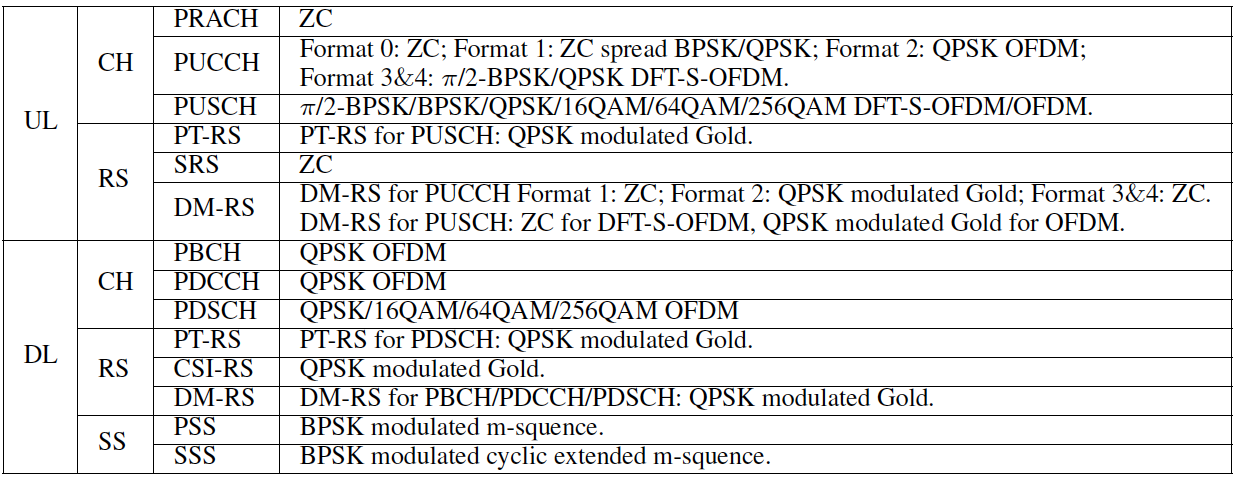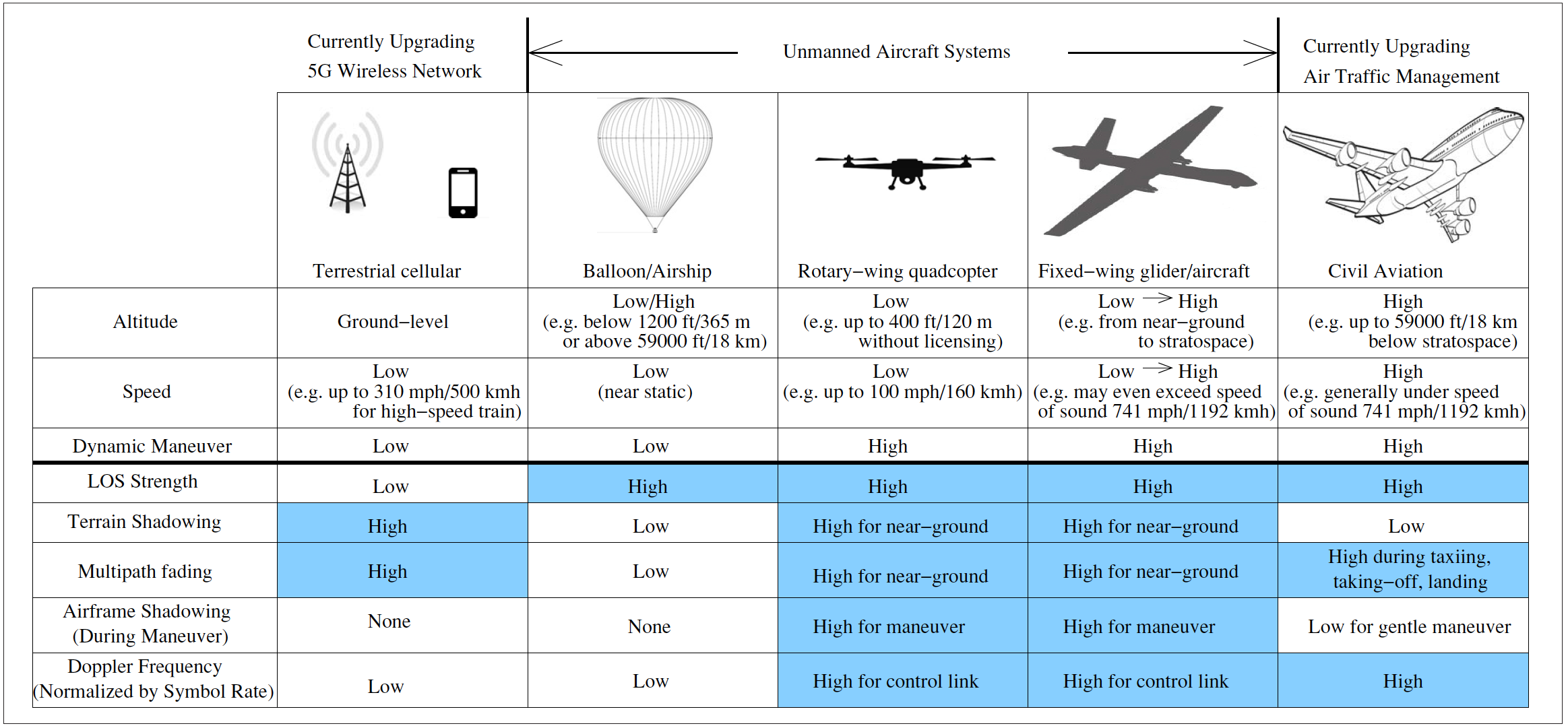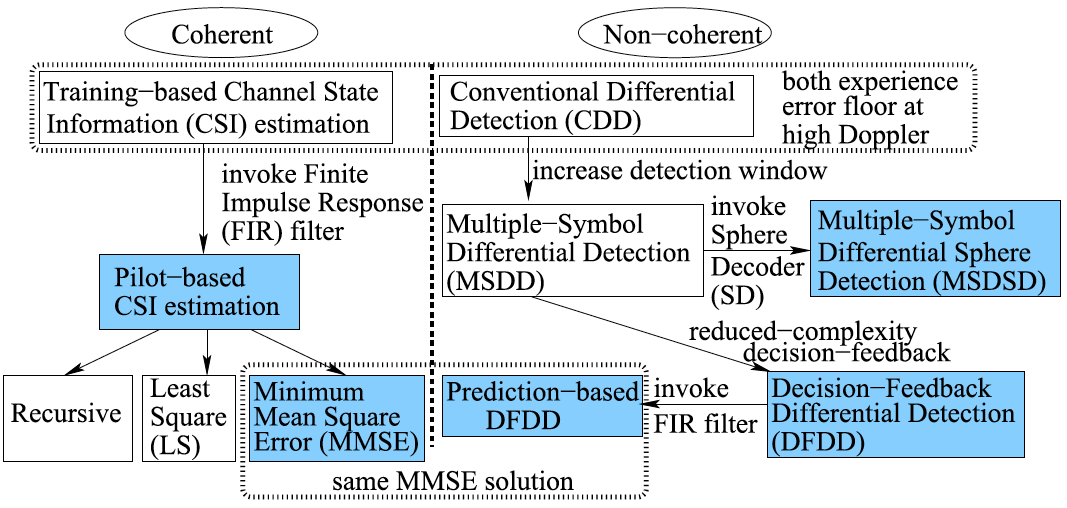You are here
6G Pervasive Intelligence
|
What has been achieved in 5G? |
|
5G aims for supporting diverse communication requirements by a unified platform. This is achieved by its unprecedented flexibility and by its agile adaptivity of communication resources and techniques. Specifically in 5G, the scalable numerology of the OFDM waveform is the key enabler, which flexibly adjust the OFDM's subcarrier spacing (SCS) in order to improve the bandwidth efficiency and reduce latency. The key upgrades from LTE to NR are summarized in Table I. First of all, given a fixed SCS of 15 kHz, LTE offers a maximum bandwidth of 20 MHz. We note that in LTE-Advanced, the maximum aggregated bandwidth is given by 100 MHz. By contrast, thanks to the scalable SCS, NR is capable of supporting at least 100 MHz per link, while backward compatibility with LTE is assured. Secondly, the Single-Carrier Frequency Division Multiple Access (SC-FDMA) signal of LTE is generated by Discrete Fourier Transform-Spread-OFDM (DFT-S-OFDM) in NR. For DFT-S-OFDM, the transform precoding of DFT and zero padding is performed before the OFDM’s IFFT stage. As a result, the unified OFDM interface is also used for the single-carrier waveform, which exhibits favourable oversampling and pulse-shaping characteristics, while its beneficially low Peak-to-Average Power Ratio (PAPR) is retained. Thirdly, in an effort to improve the performance and yet to reduce latency, the Turbo code and Tail-Biting Convolutional Code (TBCC) of LTE were replaced by Low-Density Parity-Check (LDPC) code and Polar code in NR for the data and control links, respectively. Fourthly, the scheduling in NR becomes more flexible, which include slot assignments to UL/DL duplex and bandwidth assignments to control/data links. Lastly, we note that HARQ in NR is always asynchronous and adaptive, where the retransmission does not have to occur at predefined instants, while the SCS can also be changed for each retransmission.
Table I Architecture comparison between 4G Long-Term Evolution (LTE) and 5G New Radio (NR) [1]. What's the cost? To answer that question, we have summarized the modulation schemes of 5G NR in Table II. First of all, the constant-envelope Zadoff-Chu (ZC) sequence is widely used as single-carrier waveform in the UL. More explicitly, the ZC sequence is constituted by a sequence of optimized phase rotations that exhibits zero auto-correlation and minimum cross-correlation. The inherent 0 dB PAPR in the discrete time domain also results in sufficiently low PAPR for the analog signal after pulse-shaping, which is beneficial for the Power Amplifiers (PAs) of the UEs, since no power-hungry linear class-A amplification is needed for low-PAPR signals. Moreover, the DFT or IDFT of a ZC sequence is given by a weighted cyclically shifted version of itself, which preserves the single-carrier waveform. Secondly, the pseudo-random Gold codes associated with low cross-correlations are also widely invoked by the OFDM waveforms of the RSs of DL and UL, as shown in Table II. Regarding the MIMO aspects, although arrays of massive antenna elements are employed in NR, only up to four and eight MIMO-layers are supported for Single-User MIMO (SU-MIMO) in the UL and DL transmissions, respectively. Furthermore, when the single-carrier DFT-S-OFDM waveform is used in the UL, only a single transmission layer is activated. Moreover, multi-layer transmission is not supported for Multi-User MIMO (MU-MIMO) in NR.
Therefore, it is demonstrated by Table II that the PHY layer inevitably imposes substantial overheads, including the control CHs and RSs, which compromise both the bandwidth efficiency and the latency in exchange for improved reliability. Furthermore, the RSs such as the DM-RSs assigned to the PUCCH and PDCCH become effectively the “overhead of overhead", where no user data is conveyed. Moreover, both the channel coding and the CRC of HARQ further increases the redundancies, where the lowest code rate in NR is as low as 30=1024 0:03. In order to alleviate overheads in LTE and NR, we will re-visit the non-coherent detectiontechniques in the next section.
Table II List of modulation schemes for PHYsical (PHY) layer CHannels (CHs), Reference Signals (RSs), Synchronization Signals (SSs) for 5G New Radio (NR) UpLink (UL) and DownLink (DL) [1]. |
|
Coherent Versus Non-Coherent Adaptivity |
|
The coherent versus non-coherent tradeoff may play an increasingly important role in the space-air-ground integrated network in the context of the following aspects. First of all, MEO and LEO satellites in space, manned and unmanned aircrafts in the air as well as trains and cars on the ground all travel at record-breaking high velocities. The high Doppler frequencies encountered may be better dealt with by non-coherent schemes. Secondly, the heterogeneous space-air-ground network is expected to deliver more frequent handovers among segment networks having different protocols and interfaces. This inevitably results in escalating overheads, which may be alleviated by non-coherent solutions. The 5G network relies on non-coherent detection for the broadcast channels, where no channel knowledge is available at the beginning of cell-search. Finally, it is particularly beneficial to employ the adaptive coherent/non-coherent technique for the control links of the high-velocity air/ground vehicles, which are normally assigned rather limited bandwidths. For example, the control link data rates for HAP fix-wing UAVs and LAP rotary-ring UAVs are estimated to be about 10 kbps and 100 kbps according to the aviation Air Traffic Management (ATM) and 3GPP recommendations, respectively. Moreover, the ATM for civil aviation mainly relies on the crowded radio and decimeter Wave (dmWave) spectrum below 3GHz. As a result, apart from the fact that the accuracy of channel estimation is severely eroded by the excessive normalized Doppler frequencies, the pilot overhead required for channel estimation would take up a higher percentage of the valuable bandwidth in low-rate control links, which may be avoided by invoking non-coherent schemes. The physical attributes and communication characteristics are summarized in Table III.
Table III Communication Systems from terrestrial cellular to unmmaned aircraft systems (UASs) to civil aviation [6]. The state-of-the-art coherent and non-coherent techniques designed for high-mobility communication networks are surveyed in Fig. 1. More explicitly, in the face of high Doppler frequency, the training-based Channel State Information (CSI) estimation that assumes a block fading may suffer from irreducible error floor in time-varying fading channels. Similar trends are also valid for Conventional Differential Detection (CDD) that detects a single data symbol based on (Nw = 2) received samples. Against this background, the pilot-based techniques constitute better choices, where the pilot symbols that are known to the receiver are periodically transmitted, while the FIR filter at the receiver may estimate and interpolate the fading channel based on Least Square (LS), Minimum Mean Square Error (MMSE) and recursive algorithms. For the differential schemes dispensing with explicit CSI estimation, Multiple-Symbol Differential Detection (MSDD) improves the performance of CDD by jointly detecting a total of (Nw − 1) data symbols based on (Nw > 2) observations. In order to mitigate the excessive MSDD complexity, Multiple-Symbol Differential Sphere Detection (MSDSD) invokes a Sphere Decoder (SD). Furthermore, the prediction-based Decision-Feedback Differential Detection (DFDD) technique opts for invoking the MMSE CSI estimation technique relying on the past decisions. We note that DFDD is a special case of MSDD using decision-feedback.
Figure 1 The state-of-the-art coherent and non-coherent technologies for high-mobility communication networks. [8].
|




